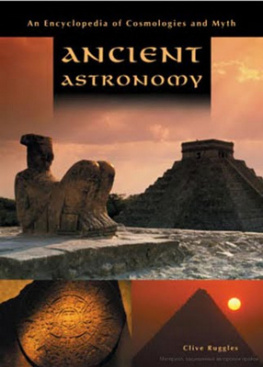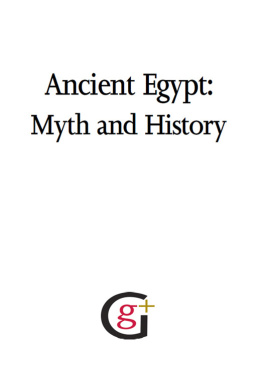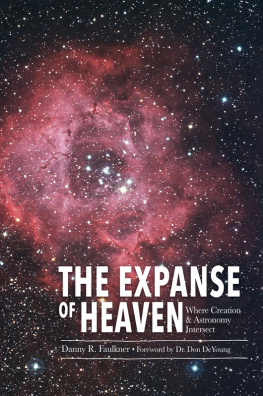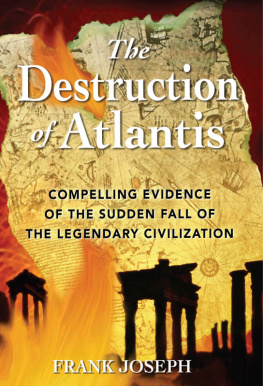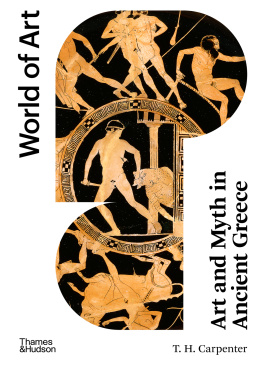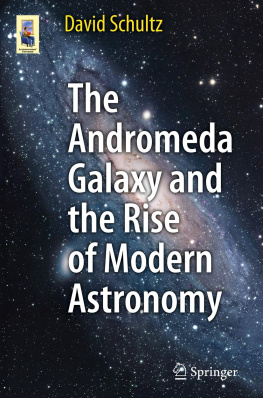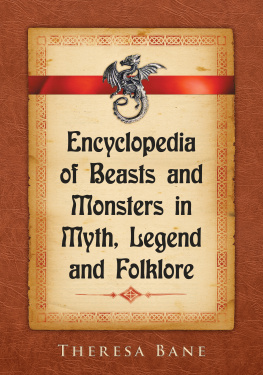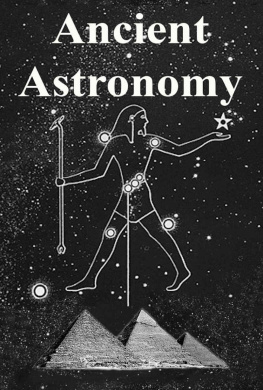All rights reserved. No part of this publication may be reproduced, stored in a retrieval system, or transmitted, in any form or by any means, electronic, mechanical, photocopying, recording, or otherwise, except for the inclusion of brief quotations in a review, without prior permission in writing from the publishers.
Ruggles, C. L. N. (Clive L. N.) Ancient astronomy : an encyclopedia of cosmologies and myth / Clive Ruggles.
p. cm. Includes bibliographical references and index. ISBN 1-85109-477-6 (acid-free paper) ISBN 1-85109-616-7 (eBook)
Astronomy, AncientEncyclopedias. 2. CosmologyEncyclopedias.
Astrology and mythologyEncyclopedias. I. Title.
This book is also available on the World Wide Web as an eBook. Visit abc-clio.com for details.
ABC-CLIO, Inc. 130 Cremona Drive, P.O. Box 1911 Santa Barbara, California 93116-1911
This book is printed on acid-free paper.
Ancient Astronomy
Aboriginal Astronomy, 1 Abri Blanchard Bone, 5 Acronical Rise, 7 Acronical Set, 7 Alignment Studies, 8 Altitude, 8 Ancient Egyptian Calendars, 9 Andean Mountain Shrines, 13 Angkor, 14 Antas, 17 Antizenith Passage of the Sun, 19 Archaeoastronomy, 19 Archaeotopography, 23 Astro-Archaeology, 24 Astrology, 24 Astronomical Dating, 27 Avebury, 29 Axial Stone Circles, 30 Azimuth, 33 Aztec Sacred Geography, 33
Babylonian Astronomy and Astrology, 37 Ballochroy, 41
Barasana Caterpillar Jaguar Constellation, 43 Beltany, 44 Borana Calendar, 45 Boyne Valley Tombs, 46 Brainport Bay, 48 Brodgar, Ring of, 50 Brown Archaeoastronomy, 52 Bush Barrow Gold Lozenge, 52
Cacaxtla, 55 Cahokia, 57 Calendars, 59 Callanish, 61 Caracol at Chichen Itza, 64 Carahunge, 65 Cardinal Directions, 67 Casa Rinconada, 69 Catastrophic Events, 72 Celestial Sphere, 74 Celtic Calendar, 75 Ceque System, 77 Chaco Canyon, 80 Chaco Meridian, 83
Content s
Chaco Supernova Pictograph, 86 Chinese Astronomy, 90 Christianization of Pagan Festivals, 95 Church Orientations, 96 Circles of Earth, Timber, and Stone, 99 Circumpolar Stars, 102 Clava Cairns, 103 Cobo, Bernab (15821657), 105 Coffin Lids, 106 Cognitive Archaeology, 108 Comets, Novae, and Meteors, 110 Compass and Clinometer Surveys, 112 Constellation Maps on the Ground, 113 Cosmology, 115 Crucifixion of Christ, 117 Crucuno, 119 Cumbrian Stone Circles, 122 Cursus Monuments, 123 Cusco Sun Pillars, 126
Declination, 129 Delphic Oracle, 130 Diurnal Motion, 132 Dresden Codex, 132 Drombeg, 134
Easter Island, 137 Eclipse Records and the Earths Rotation, 141 Ecliptic, 142 Egyptian Temples and Tombs, 143 Emu in the Sky, 147 Equinoxes, 148 Ethnoastronomy, 152 Ethnocentrism, 152 Extinction, 153
Fajada Butte Sun Dagger, 155 Field Survey, 158 Fiskerton, 160
Governors Palace at Uxmal, 163 GPS Surveys, 165 Grand Menhir Bris, 166 Green Archaeoastronomy, 169 Gregorian Calendar, 169 Group E Structures, 170
Haamonga-a-Maui, 175 Hawaiian Calendar, 176 Heliacal Rise, 180 Hesiod (Eighth Century B . C . E .), 181 Hopewell Mounds, 183 Hopi Calendar and Worldview, 186 Horizon Calendars of Central Mexico, 188 How the Sky Has Changed over the Centuries, 190
Inferior Planets, Motions of, 191 Inuit Cosmology, 193 Iron-Age Roundhouses, 195 Is Paras, 197 Islamic Astronomy, 199 Island of the Sun, 203
Javanese Calendar, 207 Julian Calendar, 208
Kintraw, 211 Kukulcan, 213 Kumukahi, 215 Kumulipo, 217
Lakota Sacred Geography, 219 Land of the Rising Sun, 221 Landscape, 223 Ley Lines, 224 Lockyer, Sir Norman (18361920), 227
Lunar and Luni-Solar Calendars,
228 Lunar Eclipses, 230 Lunar Parallax, 234 Lunar Phase Cycle, 235
Maes Howe, 237 Magellanic Clouds, 240 Mangareva, 241 Maya Long Count, 243 Medicine Wheels, 246 Megalithic Astronomy, 248 Megalithic Calendar, 248 Megalithic Monuments of Britain
and Ireland, 250 Megalithic Observatories, 252 Meridian, 253 Mesoamerican Calendar Round, 255 Mesoamerican Cross-Circle Designs,
259 Methodology, 261 Mid-Quarter Days, 265 Minoan Temples and Tombs, 266 Misminay, 267 Mithraism, 269 Monuments and Cosmology, 271 Moon, Motions of, 272 Mursi Calendar, 274
N Pali Chant, 279 Nabta Playa, 282 Namoratunga, 284 Nasca Lines and Figures, 286 Nationalism, 292 Navajo Cosmology, 293 Navajo Hogan, 295 Navajo Star Ceilings, 296 Navigation, 298 Navigation in Ancient Oceania, 300 Nebra Disc, 304 Necker Island, 307 Newgrange, 309 Nissen, Heinrich (18391912), 312 Nuraghi, 313
Obliquity of the Ecliptic, 317 Orientation, 319 Orion, 321
Palaeoscience, 325 Pantheon, 328 Pawnee Cosmology, 329 Pawnee Earth Lodge, 331 Pawnee Star Chart, 332 Pilgrimage, 333 Polynesian and Micronesian
Astronomy, 336 Polynesian Temple Platforms and
Enclosures, 340 Power, 343 Precession, 345 Precision and Accuracy, 347 Prehistoric Tombs and Temples in
Europe, 348 Presa de la Mula, 351 Pyramids of Giza, 353
Quipu, 357
Recumbent Stone Circles, 361 Refraction, 364 Roman Astronomy and Astrology,
365 Rujm el-Hiri, 366
Sacred Geographies, 369 Sarmizegetusa Regia, 370 Saroeak, 372 Science or Symbolism?, 375 Short Stone Rows, 376 Sky Bears, 378 Solar Eclipses, 380 Solstices, 384 Solstitial Alignments, 385
Contents vii
Solstitial Directions, 388 Taulas, 417 Somerville, Boyle (18641936), 389 Temple Alignments in Ancient Son Mas, 390 Greece, 419 Space and Time, Ancient Perceptions Teotihuacan Street Grid, 421 of, 390 Theodolite Surveys, 423 Star and Crescent Symbol, 392 Thom, Alexander (18941985), 425 Star Compasses of the Pacific, 394 Thornborough, 427 Star Names, 396 Tri-Radial Cairns, 429 Star of Bethlehem, 396 Star Rising and Setting Positions, 398 Venus in Mesoamerica, 433 Statistical Analysis, 399 Stone Circles, 401 Wedge Tombs, 435 Stonehenge, 405 Sun, Motions of, 409 Years B . C . E . and Years before 0, 439 Superior Planets, Motions of, 410 Yekuana Roundhouses, 439 Swedish Rock Art, 412 Symbols, 414 Zenith Passage of the Sun, 443 Zenith Stars in Polynesia, 444 Zenith Tubes, 445
Bibliography, 44 Glossary, 48 Topic Index, 48 Geographical Index, 49 Chronological Index, 49 Cultural Index, 49 Index, 50
Introductio n
The Wonder of the Skies
The sight of a truly dark night sky is simply breathtaking. In the modern world it is denied to all but those who still live, or might occasionally venture, well be yond the glare of city lights and the effects of atmospheric pollution. For people in the past, though, the panoply of thousands of stars was a familiar sight. Some twinkled particularly brightly; others hovered on the borderline of visibility. A few were tinted orange or blue. They formed distinct patterns that moved around but never changed. The Milky Way was a familiar sight to all, snaking across the heavens with its light and dark patches forming recognizable shapes. The sky also contained numerous isolated faint and fuzzy objects (nebulae), fixed among the stars, as well as bright wandering stars (planets), and of course the moon, dominating the night sky, lighting the way by night, and rendering many of its fainter companions temporarily invisible. Added to all this was the occa sional appearance of something rare or totally unexpected: a shower of meteors (shooting stars), a lunar eclipse, an aurora (at high latitudes), ormore seldom stilla comet (often perceived as a tailed or plumed star) or a new star (nova).

